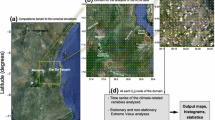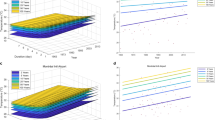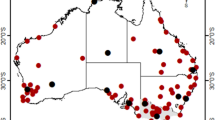Abstract
The statistical properties of the excursions of maximum daily temperatures above various critical thresholds of interest are analyzed with a view to developing models of heat wave events using more than 100 years of record from meteorological stations in Lake City, DeFuniak Springs, Avon Park, and Fort Myers, Florida. These stochastic variables include; event density (number of such events per unit time), duration, timing, and peak values over the threshold. The theoretical basis for the modeling is found in Crossing Theory. The methodology has the flexibility to extrapolate to such levels while also having the advantage of being able to be applied to spatially differentiated data to determine risks associated with high-temperature events during any time period or at any location of interest.










Similar content being viewed by others
References
Aprilesi G, Marsequerra M, Morelli S, Rivasi MF, Saltini G, Santangelo R (1977) Stochastic behavior of the daily minimum, mean and maximum temperatures in Modena, Italy. Mon Weather Rev 105:1434–1441
Arguez A, O’Brien JJ, Smith SR (2009) Air temperature impacts over Eastern North America and Europe associated with low-frequency North Atlantic SST variability. Int J Climatol 29:1–10
Birikundavyi S, Rousselle J (1997) Use of partial duration series for single station regional analysis of floods. J Hydrol Eng 2:68–75
CDC (2006) Heat-related deaths—United States, 1999–2003. MMWR - Morb Mortal Wkly Rep 55(29):796–798
Costello A, Abbas M, Allen A, Ball S, Bell S, Bellamy R et al (2009) Managing the health effects of climate change: Lancet and University College London Institute for Global Health Commission. Lancet 373:1693–1733
Cramer H, Leadbetter MR (1967) Stationary and related stochastic processes. Wiley, New York
Crutcher HL (1975) A note on the possible misuse of the Kolmogorov–Smirnov test. J Appl Meteorol 14:1600–1603
Curriero FC, Heiner KS, Samet JM, Zeger SL, Strug L, Patz JA (2002) Temperature and mortality in 11 cities of the eastern United States. Am J Epidemiol 155:80–87
Enfield DB, Mestas-Nunez AM, Trimble PJ (2001) The Atlantic multidecadal oscillation and its relation to rainfall and river flows in the continental U.S. Geophys Res Lett 28:2077–2080
Gaffen DJ, Ross RJ (1998) Increased summertime heat stress in the US. Nature 396:529–530
Gershunov A, Barnett PT (1997) ENSO influence on intraseasonal extreme rainfall and temperature frequencies in the contiguous United States: observations and model results. J Clim 11:1575–1586
Goto-Maede Y, Shin DW, O’Brien JJ (2008) Freeze probability of Florida in a regional climate model and climate indices. Geophys Res Lett 35:L11703. doi:10.1029/2008GL033720
Hajat S, Kovats RS, Atkinson RW, Haines A (2002) Impact of hot temperatures on death in London: a time series approach. J Epidemiol Community Health 56:367–372
IPCC (2007) In: Solomon S, Qin D, Manning M, Chen Z, Marquis M, Averyt KB, Tignor M, Miller HL (eds) Climate Change 2007: The Physical Science Basis. Contribution of Working Group I to the Fourth Assessment Report of the Intergovernmental Panel on Climate Change. Cambridge University Press, Cambridge, p 996
Kerr R (2000) A North Atlantic climate pacemaker for the centuries. Science 288:1984–1986
Kerr R (2008) Climate change hotspots mapped across the United States. News focus. Science 321:909
Knight JR, Folland CK, Scaife AA (2006) Climate impacts of the Atlantic Multidecadal oscillation. Geophys Res Lett 33:L17706. doi:10.1029/2006GL026242
Kunst AE, Looman CWN, Mackenbach JP (1993) Outdoor air temperature and mortality in the Netherlands: a time-series analysis. Am J Epidemiol 137:331–341
Larsen GA, Pense RB (1982) Stochastic simulation of daily climatic data for agronomic models. Agron J 74:510–514
Leadbetter MR, Lindgren G, Rootzen H (1983) Extreme and related properties of random sequences and processes. Springer, New York
LeBoutillier DW, Waylen PR (1988) Stochastic analysis of cold spells. J Appl Meteor 27:67–76
Marshall CH, Pielke RA, Steyaert LT, Willard DA (2004) The impact of anthropogenic land-cover change on the Florida peninsula sea breezes and warm season sensible weather. Mon Weather Rev 132:28–52
McCabe GJ, Palecki MA (2006) Multidecadal climate variability of global lands and oceans. Int J Climatol 26:849–865
Meehl GA, Tebaldi C (2004) More intense, more frequent and longer lasting heat waves in the 21st century. Science 305:994–997
Meze-Hausken E (2008) On the (im-)possibilities of defining human climate thresholds. Clim Change 89:299–324
National Weather Service (2009) Glossary. Retrieved September 15, 2009, from http://www.weather.gov/glossary/index.php?letter=h
Rice SO (1954) Mathematical analysis of random noise. Bell Syst Tech J 24:24–56
Rodriguez-Iturbe I, Bras R (1985) Random functions and hydrology. Addison-Wesley, Toronto
Ross SM (1976) Introduction to probability models. Academic, New York
Rousselle J (1972) On some problems of flood analysis. Ph.D. Thesis. Colorado State University: Fort Collins
Sheridan SC, Kalkstein LS (2004) Progress in heat-watch warning system technology. Bull Am Meteorol Soc 85:1931–1941
Sutton RT, Hodson DLR (2005) Atlantic Ocean forcing of North American and European summer climate. Science 309:115–118
Taesombut V, Yevjevich V (1978) Use of partial flood series for estimating distribution of maximum annual flood peak. Colorado State University. Hydrol Pap 97:71
Tan JG, Zheng Y, Kalkstein LS, Song G, Kalkstein AJ, Tang X (2007) Heat wave impacts on mortality in Shanghai, 1998 and 2003. Int J Biometeorol 51:193–200
Waylen PR (1988) Statistical analysis of freezing temperatures in Central and Southern Florida. Int J Climatol 8:607–628
Waylen PR, LeBoutillier DW (1989) Statistical properties of freeze date variables and the length of the growing season. J Clim 2:1314–1328
Waylen PR, Woo MK (1983) Stochastic analysis of high flows generated by mixed processes. Can J Civ Eng 10:639–648
World Health Organization Europe (1998) Heat health action plans. Retrieved July 20, 2009, from http://www.euro.who.int/document/e91347.pdf
World Health Organization Europe (2009) Improving public health responses to extreme weather/heat-waves EuroHEAT technical summary. Retrieved September 19, 2009, from http://www.euro.who.int/Document/E92474.pdf
World Meteorological Organization (1983) Guide to climatological practices. WMO. 185 pp
Author information
Authors and Affiliations
Corresponding author
Rights and permissions
About this article
Cite this article
Keellings, D., Waylen, P. The stochastic properties of high daily maximum temperatures applying crossing theory to modeling high-temperature event variables. Theor Appl Climatol 108, 579–590 (2012). https://doi.org/10.1007/s00704-011-0553-2
Received:
Accepted:
Published:
Issue Date:
DOI: https://doi.org/10.1007/s00704-011-0553-2




